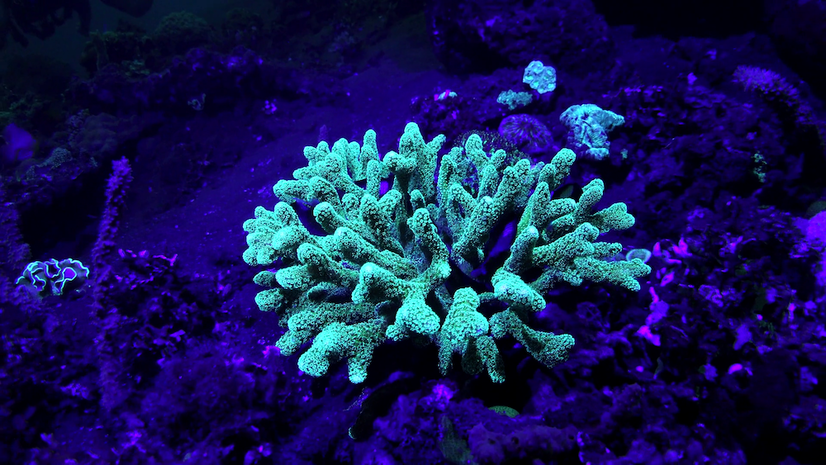
Coral colony fluorescing under UV-light in the Philippines. (Photo credits: pictureboss.com)
We humans have lost our natural barriers against harmful UV-rays...Fur, dust and mud use to be our sun-screens. Today, our skin's health depends on the use of protective clothing and creams. Corals on the other hand, had to come up with a better solution to withstand the damaging effects of excessive sun exposure. Corals are a complex mix of plant and animal...they start their life as larvae floating in the water column, but eventually have to settle for life on the reef - ideally somewhere sunny - as they require the energy of the sun to grow into large coral colonies. Being stationary animals, corals can't take shelter from the sun when they've had enough of it, or apply sunscreen during the strong hours of the sun...Or is there something we can’t see? Something hiding under the surface?
When shining a special type of light on the reef, corals reveal colours that cannot be seen with the naked eye. They become fluorescent under UV-light (or more commonly known as black light). For many years, we enjoyed the beauty of coral flurorescence without really knowing it's origin and importance. In the 2000's, studies revealed that fluorescence may actually be a way for corals to protect their skin from the sun (Roth et al., 2006). Special proteins within the coral tissue are responsible for synthesising a layer of fluorescent pigments (called FP layer) that - very much like an inbuilt sunscreen - is capable of regulating the amount of light that the coral is exposed to in a process called photo-protection.

Corals "inbuilt sunscreen" isn't visible to the naked eye (left) but can be revealed under ultra violet light (right). photo: Bob Yin
In excessive sunlight, the FP layer is able to dissipate excess energy into wavelengths, restoring suitable condition for photosynthesis and healty coral function. It is also believed that fluorescent proteins can help corals through period of heat stress by reducing oxidative stress within the coral tissue, thus keeping corals from bleaching for longer periods (Roth et al., 2006; Shalin et al., 2000; Bou-Abdallah et al., 2006). During a bleaching event, the fluorescent layer becomes visible under normal light as all other pigments within the coral dermis have been lost (see picture below). In that context, the FP layer can be considered the last line of defence for severely bleached corals during a marine heat wave. Much more than a sun-protection layer, the FP layer could help enhance resistance of corals to mass-bleaching...read more about coral bleaching here.

Although beautiful, fluorescence in this picture reveals corals under great thermal stress. During a process called coral-bleaching these corals have lost all their natural skin pigments, revealing the natural fluorescent protein layer (FP) within their tissue. photo: People4Ocean.
References:
- Anya, S., Larkum, A., Cox, G., Kuhl, M. & Hoegh-Guldberg, O. Fluorescent pigment in corals and photoprotective. Nature, 408 850-853 (2000).
- Roth, M. S., Latz, M. I., Goericke, R., & Deheyn, D. D. Green fluorescent protein regulation in the coral Acropora yongei during photo acclimation. The Journal of Experimental Biology, 213, 3644-3655.
- Bou-Abdallah, F., Dennis Chasteen, N. & Lesser, M. P. Quenching of Superoxide Radicals by Green Fluorescent Protein. Biochim Biophys Acta, 1760(11): 1690-1695.


Comments (0)
Back to Blog